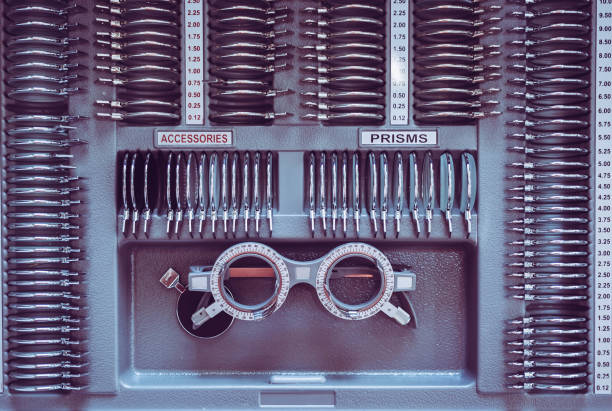
Guide to Picking Glasses That Suit Your Face Shape Perfectly
February 27,2023

What is Boho Style? A Comprehensive Guide to Boho-Chic Fashion
February 13,2025

Virtual Glasses Try On - Find Your Perfect Pair Online
April 02,2024

UV Protection Glasses VS. Blue Light Glasses - Vooglam
July 20,2023

Newest Style Modern Trendy Mens Glasses | Vooglam
March 01,2024

Stylish Reading Glasses: Blending Fashion with Functionality
February 16,2023

What are photochromic lenses & glasses?
September 22,2023

Brown Eyes: The Beauty of the Most Common Hue
September 01,2024

The chubby face glasses for round face female
August 02,2023

What are prisms in eyeglasses?
March 20,2023

What Are Bifocal Glasses? The Complete Guide (Types, History & Benefits)
April 14,2023

How to Read Your Eyeglass Prescription?
March 11,2023
What are prisms in eyeglasses?
Prisms in eyeglasses can be used as an important component to help correct vision problems. They play a key role in improving vision, treating eye alignment problems, and improving depth perception. In this article, we will explore what prisms are in eyeglasses, the uses of prisms in eyeglasses, understanding prescriptions and how to fit prisms, and possible side effects and precautions for wearing prism prescription eyeglasses.
Learn about prisms
Prisms are transparent optical elements with flat, polished surfaces that refract light, bending it and changing its direction. They work by refracting the light that passes through them, creating a displacement or shift in the position of the image. The basic geometry of a prism consists of a triangular piece of glass or plastic with two parallel bases and three rectangular faces. The angle between the two bases determines the prism's power, while the prism's orientation affects the direction in which the light travels.

Prisms affect light and vision by changing the way light enters the eye. They are commonly used in eyeglasses to help redirect light and adjust the eye. Several types of prisms are typically used in eyeglasses, including horizontal, vertical, and oblique prisms.
The Power of Prisms in Eyeglasses
Prisms in eyeglasses have several uses, including correcting alignment problems in the eye, treating diplopia or double vision, improving vision in certain eye conditions, and enhancing depth perception. They are particularly useful in situations where traditional eyeglasses or contact lenses are not sufficient to correct vision problems.

- Correcting Eye Alignment Problems: Prisms can be used to correct misalignment or strabismus, a condition in which the eyes are not properly aligned. This misalignment can lead to diplopia and depth perception problems. Prisms can be used to help realign the eyes and restore vision in one eye.
- Treatment of diplopia: Diplopia can be caused by a variety of conditions, including muscle weakness or nerve damage. Prisms can be used to correct diplopia by redirecting light and realigning the images seen by each eye.
- Improves Vision: Prisms can also be used to improve vision in certain eye conditions, such as amblyopia, where vision in one eye is significantly weaker than the other. By redirecting light and adjusting the image seen by each eye, prisms can help improve the vision of weaker eyes.
- Enhanced Depth Perception: Prisms can also help improve depth perception by adjusting the image seen by each eye, providing a more accurate perception of depth and distance.
Prism prescription and fitting
The prescription for prisms in eyeglasses includes two important factors: prism power and orientation. Prism power refers to the strength of the prism, measured as the prism diopters (PD), which determines how much light is bent. Prism orientation refers to the direction in which the prism base is placed. Prisms can have different orientations, depending on the direction of deviation or diplopia. For example, if a person has a problem with upward deviation in one eye, a base-down prism would be fitted to that eye to help align it with the other eye.
Accurate fitting of the prism is predicated on accurate measurement of the prescription to ensure proper fitting of the prism to avoid any visual distortion or discomfort. Incorrect placement of prisms can lead to vision loss and even worsen potential vision problems.

Possible side effects you should know in advance
Using prisms in eyeglasses may have side effects. It may take some time for the eyes and brain to adjust to the new visual information provided by the prisms. During this time, a person may experience some discomfort or visual distortions, such as headaches or dizziness. However, over time, these symptoms usually improve as the eyes and brain adjust to the new correction.
Another potential side effect of using prisms in eyeglasses is visual distortion. Because prisms bend light, they can cause objects to appear closer or farther away than they are. This effect can be particularly noticeable in certain situations, such as when looking through the side of the lens. However, these distortions are usually minor and do not affect the overall effect of prismatic correction.

Conclusion
If you are experiencing eye alignment, diplopia, and other complex refraction-related vision problems, you will likely benefit from a prismatic correction. With proper diagnosis, prescription, and fitting, prismatic eyeglasses can greatly improve your vision and quality of life.
It is also important to have regular eye exams and monitor changes in your vision when using prism lenses in eyeglasses. Vision can change over time, and it may be necessary to adjust your prism prescription. A qualified eye care professional can monitor these changes and make appropriate adjustments to ensure that prismatic correction remains effective.

Vooglam Blog
Vooglam blog shares professional knowledge about eyeglass frames, lenses, etc., and provides help when purchasing and using eyewear products. At the same time, Vooglam focuses on fashion glasses to interpret the trend of glasses for you.

































